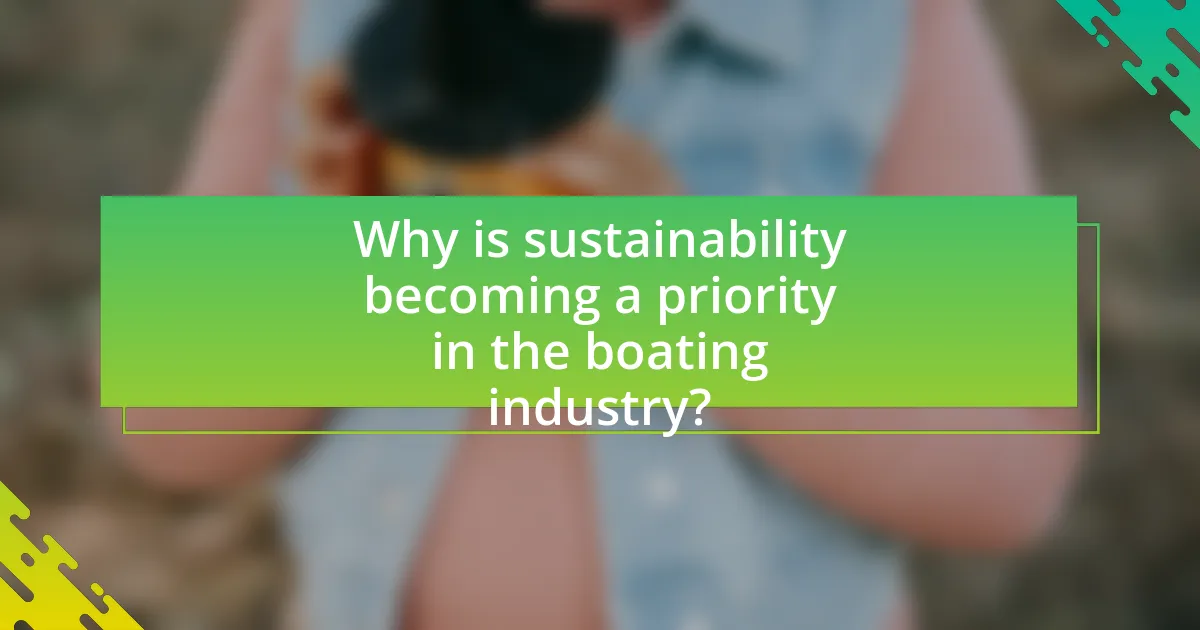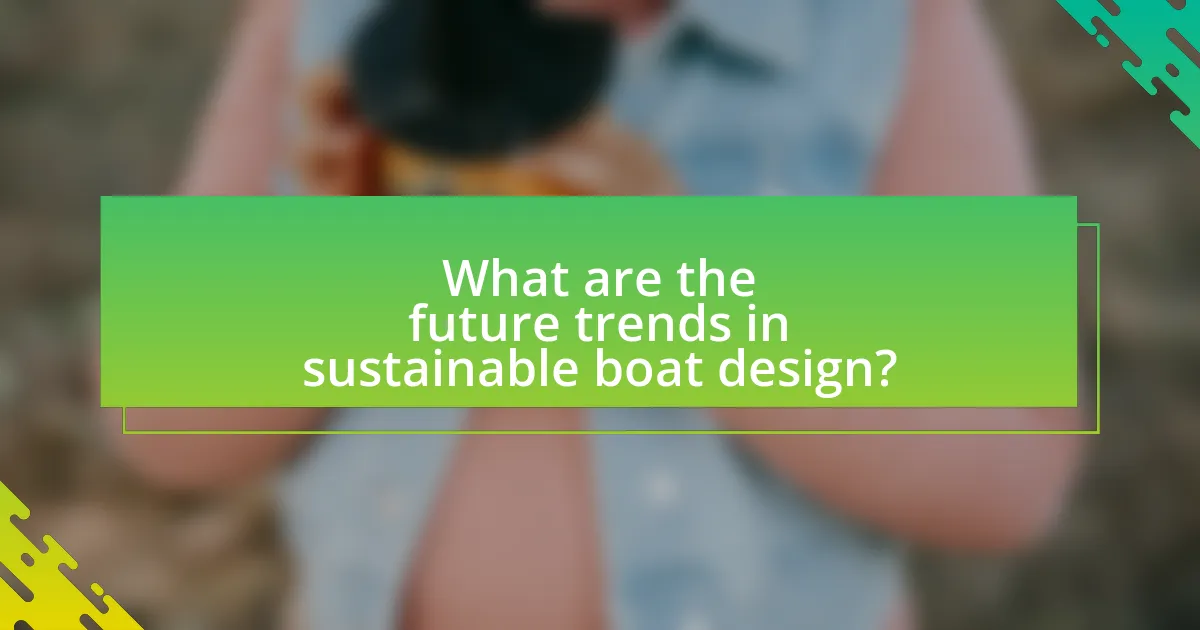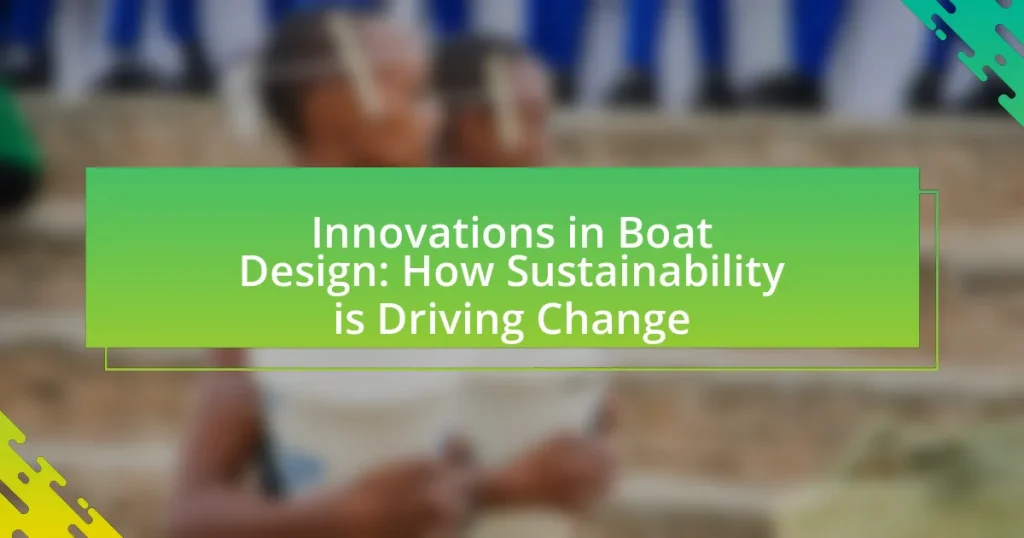The article focuses on innovations in boat design driven by sustainability, highlighting key advancements such as the use of alternative materials, energy-efficient propulsion systems, and eco-friendly manufacturing processes. It discusses the evolution of materials in boat construction, including bio-based resins and recycled plastics, and examines how these materials impact the environmental footprint of boats. The article also explores design features that enhance sustainability, the role of renewable energy sources, and the regulatory pressures influencing the boating industry. Additionally, it addresses consumer preferences for eco-friendly options and outlines future trends in sustainable boat design, emphasizing the importance of collaboration and practical steps for boat owners to support sustainability.

What are the key innovations in boat design driven by sustainability?
Key innovations in boat design driven by sustainability include the use of alternative materials, energy-efficient propulsion systems, and eco-friendly manufacturing processes. Alternative materials such as recycled plastics and natural fibers reduce environmental impact while enhancing durability. Energy-efficient propulsion systems, including electric and hybrid engines, significantly lower emissions and fuel consumption. Additionally, eco-friendly manufacturing processes, such as 3D printing and modular construction, minimize waste and resource use. These innovations collectively contribute to a more sustainable boating industry, aligning with global efforts to reduce carbon footprints and promote environmental stewardship.
How are materials evolving in sustainable boat design?
Materials in sustainable boat design are evolving through the adoption of eco-friendly alternatives and advanced composites. Innovations such as bio-based resins, recycled plastics, and natural fibers are being integrated into boat construction to reduce environmental impact. For instance, the use of flax and hemp fibers in place of traditional fiberglass not only lowers carbon emissions but also enhances biodegradability. Additionally, manufacturers are increasingly utilizing lightweight materials like aluminum and carbon fiber, which improve fuel efficiency and performance while minimizing resource consumption. These advancements reflect a broader trend towards sustainability in the marine industry, driven by regulatory pressures and consumer demand for greener products.
What alternative materials are being used in modern boat construction?
Modern boat construction increasingly utilizes alternative materials such as fiberglass, aluminum, and composite materials. Fiberglass is favored for its lightweight and corrosion-resistant properties, making it ideal for various boat types. Aluminum offers strength and durability while being recyclable, contributing to sustainability efforts. Composite materials, which combine different substances like carbon fiber and resin, provide enhanced performance and reduced weight, further promoting efficiency in boat design. These materials reflect a shift towards sustainable practices in the marine industry, aligning with the growing emphasis on environmental responsibility.
How do these materials impact the environmental footprint of boats?
Materials used in boat construction significantly impact the environmental footprint of boats by influencing resource consumption, emissions, and waste generation. For instance, traditional materials like fiberglass and aluminum require substantial energy for production and often result in harmful emissions during manufacturing. In contrast, sustainable materials such as recycled plastics and natural fibers reduce energy consumption and emissions, as they often utilize less energy-intensive processes and can be sourced from renewable resources. Research indicates that using bio-based composites can lower the carbon footprint of boats by up to 30% compared to conventional materials, demonstrating a clear advantage in sustainability.
What design features enhance sustainability in boats?
Design features that enhance sustainability in boats include the use of lightweight materials, energy-efficient propulsion systems, and renewable energy sources. Lightweight materials, such as advanced composites and aluminum, reduce fuel consumption by decreasing the overall weight of the vessel. Energy-efficient propulsion systems, like hybrid or electric engines, minimize emissions and reliance on fossil fuels. Additionally, integrating renewable energy sources, such as solar panels and wind turbines, allows boats to harness natural energy, further reducing their environmental impact. These features collectively contribute to a more sustainable boating industry by lowering carbon footprints and promoting eco-friendly practices.
How does hull design contribute to fuel efficiency?
Hull design significantly contributes to fuel efficiency by optimizing hydrodynamic performance, which reduces resistance as a vessel moves through water. A well-designed hull minimizes drag, allowing for smoother navigation and less energy expenditure. For instance, research indicates that a streamlined hull shape can reduce fuel consumption by up to 20% compared to traditional designs. This efficiency is achieved through features such as a sharper bow, a flatter bottom, and a tapered stern, which collectively enhance the vessel’s ability to cut through water with minimal turbulence.
What role do renewable energy sources play in modern boat design?
Renewable energy sources are integral to modern boat design, significantly enhancing sustainability and reducing environmental impact. The incorporation of solar panels, wind turbines, and hybrid propulsion systems allows boats to operate with minimal reliance on fossil fuels, thereby decreasing greenhouse gas emissions. For instance, the use of solar energy can power onboard systems and propulsion, as seen in vessels like the Energy Observer, which is powered entirely by renewable sources. This shift not only aligns with global sustainability goals but also meets increasing consumer demand for eco-friendly marine solutions.

Why is sustainability becoming a priority in the boating industry?
Sustainability is becoming a priority in the boating industry due to increasing environmental regulations and consumer demand for eco-friendly practices. The boating sector faces pressure to reduce its carbon footprint and minimize pollution, as evidenced by the International Maritime Organization’s regulations aimed at reducing greenhouse gas emissions from ships by at least 50% by 2050. Additionally, a 2021 survey by the National Marine Manufacturers Association found that 70% of boat buyers consider sustainability an important factor in their purchasing decisions. This shift is driving innovations in boat design, such as the development of electric propulsion systems and the use of sustainable materials, to meet both regulatory requirements and consumer expectations.
What are the environmental impacts of traditional boat manufacturing?
Traditional boat manufacturing has significant environmental impacts, primarily due to the use of non-sustainable materials and processes. The construction often involves harvesting hardwoods, which can lead to deforestation and loss of biodiversity. For instance, the use of tropical hardwoods contributes to habitat destruction and carbon emissions, as these trees play a crucial role in carbon sequestration. Additionally, the application of toxic paints and varnishes during the finishing process can result in water pollution, affecting marine ecosystems. Studies have shown that traditional boat manufacturing can release harmful substances into waterways, disrupting aquatic life and contaminating drinking water sources.
How does boat waste affect marine ecosystems?
Boat waste negatively impacts marine ecosystems by introducing pollutants and harmful substances into the water. This waste, which includes sewage, oil, and hazardous materials, can lead to nutrient pollution, causing algal blooms that deplete oxygen levels and harm aquatic life. For instance, the Environmental Protection Agency reports that recreational boats contribute approximately 10% of the total nitrogen pollution in coastal waters, which can disrupt the balance of marine ecosystems. Additionally, plastics from boat waste can entangle marine animals and degrade habitats, further threatening biodiversity.
What regulations are influencing sustainable practices in boat design?
Regulations influencing sustainable practices in boat design include the International Maritime Organization’s (IMO) MARPOL Convention, which sets limits on marine pollution, and the European Union’s Directive on the Energy Performance of Buildings, which encourages energy efficiency in marine structures. These regulations mandate the reduction of emissions and waste, promoting the use of eco-friendly materials and technologies in boat construction. For instance, the IMO’s 2020 sulfur cap requires vessels to limit sulfur emissions to 0.5%, driving the adoption of cleaner fuels and innovative propulsion systems. Additionally, the EU’s Green Deal aims to make the maritime sector more sustainable, further pushing boat manufacturers to integrate sustainable practices into their designs.
How are consumer preferences shifting towards sustainable boating?
Consumer preferences are increasingly shifting towards sustainable boating as buyers prioritize eco-friendly materials and technologies. This shift is evidenced by a growing demand for electric and hybrid propulsion systems, which reduce emissions and reliance on fossil fuels. According to a 2022 report by the National Marine Manufacturers Association, 40% of boat buyers expressed a preference for environmentally sustainable options, highlighting a significant trend towards greener choices in the boating industry. Additionally, manufacturers are responding by integrating renewable energy sources, such as solar panels, into boat designs, further aligning with consumer values focused on sustainability.
What trends are emerging in the market for eco-friendly boats?
Emerging trends in the market for eco-friendly boats include the increased use of electric propulsion systems, the incorporation of sustainable materials, and advancements in solar technology. Electric propulsion systems are gaining traction as manufacturers aim to reduce emissions and reliance on fossil fuels; for instance, companies like Torqeedo are leading the way with electric outboard motors that offer zero emissions. Additionally, the use of sustainable materials such as recycled plastics and bamboo in boat construction is becoming more prevalent, reflecting a shift towards environmentally responsible manufacturing practices. Furthermore, solar technology is being integrated into boat designs, allowing for renewable energy generation onboard, which enhances energy efficiency and reduces the carbon footprint of marine activities. These trends indicate a significant movement towards sustainability in the boating industry, driven by consumer demand for greener alternatives.
How do consumers perceive the value of sustainable features in boats?
Consumers perceive the value of sustainable features in boats as significant, often associating them with environmental responsibility and long-term cost savings. Research indicates that 70% of boat buyers prioritize eco-friendly options, viewing them as essential for reducing their carbon footprint and enhancing brand reputation. Additionally, sustainable features, such as energy-efficient engines and recyclable materials, are increasingly seen as indicators of innovation and quality, leading to higher consumer satisfaction and loyalty. This perception is supported by a study from the National Marine Manufacturers Association, which found that 65% of consumers are willing to pay a premium for boats with sustainable attributes.

What are the future trends in sustainable boat design?
Future trends in sustainable boat design include the increased use of renewable energy sources, such as solar and wind power, and the incorporation of eco-friendly materials like recycled plastics and bio-composites. These advancements aim to reduce the environmental impact of boating. For instance, solar panels integrated into boat surfaces can significantly decrease reliance on fossil fuels, while bio-composite materials can lower carbon footprints during production. Additionally, advancements in hydrodynamics and hull design are expected to enhance fuel efficiency, further promoting sustainability in the maritime industry.
How is technology shaping the future of sustainable boating?
Technology is shaping the future of sustainable boating through advancements in electric propulsion, renewable energy integration, and smart materials. Electric propulsion systems, such as battery-powered motors, significantly reduce greenhouse gas emissions compared to traditional fossil fuel engines. For instance, the International Maritime Organization reports that transitioning to electric vessels can cut emissions by up to 90%.
Renewable energy sources, like solar panels and wind turbines, are increasingly being incorporated into boat designs, allowing vessels to harness natural energy for propulsion and onboard power needs. A study by the European Commission highlights that integrating solar energy can decrease fuel consumption by 30% in hybrid systems.
Additionally, the use of smart materials, such as lightweight composites and biodegradable components, enhances fuel efficiency and reduces environmental impact. Research from the Journal of Cleaner Production indicates that lightweight materials can improve a vessel’s energy efficiency by 15-20%.
These technological innovations collectively contribute to a more sustainable boating industry, aligning with global efforts to reduce environmental footprints and promote eco-friendly practices.
What innovations in propulsion systems are being developed?
Innovations in propulsion systems being developed include electric and hybrid propulsion technologies, which aim to reduce emissions and improve fuel efficiency in marine vessels. Electric propulsion systems utilize batteries and electric motors, significantly lowering greenhouse gas emissions compared to traditional diesel engines. Hybrid systems combine conventional engines with electric power, allowing for greater flexibility and efficiency in various operating conditions. Additionally, advancements in hydrogen fuel cell technology are being explored, offering a zero-emission alternative for marine applications. These innovations are supported by increasing regulatory pressures for sustainability and the growing demand for eco-friendly maritime solutions.
How are smart technologies enhancing sustainability in boats?
Smart technologies are enhancing sustainability in boats by optimizing energy consumption and reducing emissions. For instance, advanced navigation systems utilize real-time data to improve route efficiency, which minimizes fuel usage. Additionally, smart sensors monitor engine performance and environmental conditions, allowing for adjustments that further decrease energy waste. According to a study by the International Maritime Organization, implementing such technologies can lead to a reduction of greenhouse gas emissions by up to 30% in marine operations. These innovations not only contribute to environmental protection but also promote cost savings for boat operators through improved fuel efficiency.
What challenges do designers face in implementing sustainable practices?
Designers face significant challenges in implementing sustainable practices, primarily due to material limitations, cost constraints, and regulatory complexities. The availability of eco-friendly materials is often restricted, making it difficult for designers to source sustainable options that meet performance standards. Additionally, sustainable materials can be more expensive than traditional alternatives, leading to budgetary challenges for projects. Regulatory frameworks can also complicate the design process, as compliance with environmental standards may require additional time and resources. These factors collectively hinder the widespread adoption of sustainable practices in boat design.
How can the industry overcome barriers to adopting sustainable materials?
The industry can overcome barriers to adopting sustainable materials by investing in research and development to improve the performance and cost-effectiveness of these materials. For instance, advancements in bio-based composites have shown potential to reduce costs while enhancing durability, making them more appealing for manufacturers. Additionally, collaboration among stakeholders, including suppliers, manufacturers, and regulatory bodies, can facilitate knowledge sharing and create standardized practices that promote the use of sustainable materials. Evidence from the Ellen MacArthur Foundation indicates that circular economy practices, which include the use of sustainable materials, can lead to significant cost savings and resource efficiency, further incentivizing the industry to adopt these innovations.
What role does collaboration play in advancing sustainable boat design?
Collaboration plays a crucial role in advancing sustainable boat design by fostering innovation and integrating diverse expertise. When designers, engineers, manufacturers, and environmental scientists work together, they can share knowledge and resources, leading to the development of eco-friendly materials and energy-efficient technologies. For instance, partnerships between boat manufacturers and research institutions have resulted in the creation of lightweight composite materials that reduce fuel consumption and emissions. Additionally, collaborative efforts often lead to the establishment of industry standards and best practices that promote sustainability across the sector, as seen in initiatives like the International Maritime Organization’s guidelines for reducing greenhouse gas emissions from ships.
What practical steps can boat owners take to support sustainability?
Boat owners can support sustainability by adopting eco-friendly practices such as using biodegradable cleaning products, implementing waste management systems, and opting for energy-efficient engines. Biodegradable cleaning products reduce harmful chemicals released into waterways, while effective waste management systems ensure proper disposal of waste, minimizing pollution. Energy-efficient engines, such as electric or hybrid options, significantly lower carbon emissions and fuel consumption, contributing to a cleaner environment. According to the International Maritime Organization, transitioning to cleaner technologies can reduce greenhouse gas emissions from shipping by up to 70% by 2050, highlighting the importance of these practical steps for boat owners.





